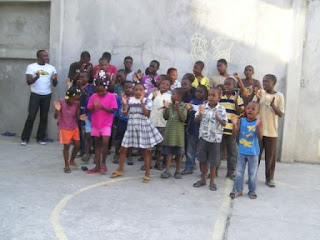Day 4
2nd Day Working in Petit-Goave
Today is day four of our mission here in Haiti and the 2nd day of work at the Petit-Goave site. We did not do any work of consequence today although we spent a lot of time playing with the kids and watching the Haitian men apply plaster to the outside of the church activity center. They are expert at applying wet, soft mud (mortar mix) to the side of the building in a rapid and exact fashion at the right thickness.
Applying Mortar Coating Inside
We helped the masonry team by mixing mortar and concrete as they apply it to the inside of the activity center today. Although there wasn’t enough work for the 8 of us to participate we worked as a team and took turns shoveling and sifting. The highlight though of today was a surprise visit by four youths and other several other smaller Haitian kids who came by to see what we were doing and to see what the “blanc” (white) people were doing. We played soccer and Frisbee in the afternoon and learned more about them as they learned more about us.
Haitian Kids at the Work Site
As one might expect, they are all good soccer players. One young man of about 15 years, had exceptional command of English and was also well versed in the Methodist religion. Nancy thought he could easily be trained in ministry or as a teacher. All the people here and especially the youth and children are very friendly and affectionate. Many of the younger children held our hands as we walked around the site and stroked our heads. It’s something that I think is pretty common when they don’t see many people like us here.
We have all agreed we are a team of individuals that have come together to do a job in Haiti, but we are having a hard time understanding what that job looks like and how it is to be accomplished. At about 3PM we came home and had a long discussion amongst the group regarding how we can be more productive with our time here since it is limited; tomorrow is Sunday we only have 2 work days left. We all wish that there wasn’t such a lack of meaningful work . We did not make any world changing conclusions but believe we must pursue most of our questions and concerns in some official manner with the UMVIM/UMCOR non-governmental organization (NGO) that arranged most of our accommodations and partially funded our project here. Steve and I calculated that UMVIM with the UMCOR matching fund is bringing about $1.5 million dollars a year into the Haitian economy assuming that there are at least 3 teams a week down here for most of the year. Of the $43 million that UMCOR has been given for Haiti relief efforts, about 10% of that is being used to match UMVIM volunteer dollars for each project. There is about $3 million more remaining in the fund which was just released for projects in October of last year.
Later that evening we had an informative discussion with Pastor Admirable about the Methodist church her e in Haiti. He said Haiti has 13 Methodist districts which each have a district superintendent. Pastor Maude is the Petit-Goave district superintendent. She and Pasto Admirable have 24 churches each that they have to attend to in this district; it takes them 6 months to see each of them (one every Sunday). There are approximately 45 lay preachers in the Petit-Goave district. There are about 7,000 to 8,000 Methodists in Haiti and about 184 schools are sponsored by the Methodists here.
Pastor Admirable’s House
Front Yard of Pastor Admirable’s House
The weather has been warm, close to 80 degrees, but it is not too humid so we can handle the heat during the day. Although it’s been fairly hot at night, each of our rooms has a fan. Unfortunately, Pastor Admirable’s house is located directly adjacent to a disco which plays very loud dance, rap, reggae and Haitian music late into the night. Most of us have been averaging 4 or 5 hours of sleep a night. They love music here as every night a truck or van drives down the road in front of our house advertising loudly that there are more dance places in Petit-Goave.
Tomorrow we are going to attend church service with Pastor Maude outside of Fond-Doux in the mountains at the Eglis-Methodiste De Nabosse church and are going to get an early start with wake-up at 6AM, breakfast at 6:30AM and to commence our journey after 7AM. That’s all for now.
- Bruce Stirling and Bob Dixon












































